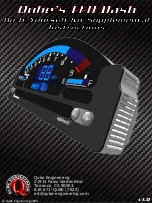
DRIVING
Learn about preparation for driving, as well as other features.
Before Driving
Check the following items before you begin driving.
n
Exterior Checks
• Make sure there are no obstructions on the windows, door mirrors,
exterior lights, or other parts of the vehicle.
• Remove any frost, snow, or ice.
• Make sure the hood is securely closed.
• Make sure the tailgate is fully closed when it is not being used as an
extended pickup bed.
• Heat from the engine and exhaust can ignite flammable materials left
under the hood, causing a fire. If you’ve parked your vehicle for an
extended period, inspect and remove any debris that may have
collected, such as dried grass and leaves that have fallen or have been
carried in for use as a nest by a small animal. Also check under the hood
for leftover flammable materials after you or someone else has
performed maintenance on your vehicle.
• Make sure the tires are in good condition.
• Make sure there are no people or objects behind or around the vehicle.
If the doors are frozen shut, use warm water around the door edges to
melt any ice. Do not try to force them open, as this can damage the
rubber trim around the doors. When done, wipe dry to avoid further
freezing.
n
Interior Checks
• Store or secure all items on board properly.
• Do not pile items higher than the seat height.
• Do not place anything in the front seat footwells. Make sure to secure
the floor mats.
• If you have any animals on board, do not let them move freely in the
vehicle.
• Securely close and lock all doors and the tailgate.
• Adjust your seating position, mirrors, and steering wheel properly.
DRIVING
84 |
• Make sure items placed on the floor behind the front seats cannot roll
under the seats.
• Everyone in the vehicle must fasten their seat belt.
• Make sure that the indicators in the instrument panel come on when
you start the vehicle, and go off soon after.
In addition:
• During the first 600 miles (1,000 km) of operation, avoid sudden
acceleration or full throttle operation so as to not damage the engine or
powertrain.
• Avoid hard braking for the first 200 miles (300 km). You should also
follow this when the brake pads are replaced.
n
Driving Guidelines for Your Utility Vehicle
Utility vehicles have a significantly higher rollover rate than other types of
vehicles. To prevent rollovers or loss of control:
• Take corners at slower speeds than you would with a passenger vehicle.
• Avoid sharp turns and abrupt maneuvers whenever possible.
• Do not modify your vehicle in any way that would raise its center of
gravity.
• Never carry more than 165 lbs (75 kg) of cargo on the roof rack (Acura
accessory).
Improperly operating this vehicle on or off pavement can cause a crash or
rollover in which you and your passengers can be seriously injured or
killed.
Follow all instructions and guidelines in this guide.
Keep your speed low and don’t drive faster than conditions permit.
Improper accessories or modifications can affect your vehicle’s handling,
stability, and performance, and cause a crash in which you can be
seriously hurt or killed.
Follow all instructions in the vehicle owner’s manual regarding
accessories and modifications.
DRIVING
| 85
















































